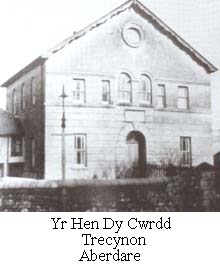History - including photographs of now closed Unitarian Places of Worship







The Seventeenth Century
In the early seventeenth century a group of Dissenters decided to defy the law and meet for worship at Blaencanaid Farm on the mountainside between Merthyr Tydfil and Aberdare. A few years later, they continued their meetings in a barn at Cwmyglo Farm. These meetings had to be arranged to watch for the law, as these worshippers would be severely punished if they were caught. The barn was used to store hay and straw during the week and cleared for the Sunday Service throughout which the Congregation stood. Many Nonconformist Chapels were built as a result of some members leaving Cwmyglo, among them, the Unitarian causes at Hen Dŷ Cwrdd, Cefncoed in 1747 and Hen Dŷ Cwrdd, Trecynon in 1751.
The congregation in Swansea was founded in 1633 although the church itself is more recent. It is a city centre church and is located at the bottom end of the High Street. Unlike most of the buildings around it, the church survived the bombing of the Second World War. Much of the interior was redesigned following a fire and the worship area is now on the first floor. There are additional rooms, including a hall on the ground floor.
Gellionnen Chapel is situated on the mountain above Pontardawe. It is one of the earliest Nonconformist causes in the area with the congregation being founded in 1692 and the chapel built in 1695, the building was extended in 1801. In 2008 a large amount of damage was done when children entered the building and destroyed the pulpit and a number of pews. Support for the Congregation came from both locally and the Unitarian denomination. The pulpit and frontage have been completely restored.
The Eighteenth Century
Yr Hen Dŷ Cwrdd, Blaengwrach in the Vale of Neath was established in 1704 and attracted its congregation from a wide area including Neath, Penderyn and Glyncorrwg. The chapel wasa rebuilt at a cost of £90 in the early 1830's but by 1851 the attendance was around 13 people. The chapel was closed in 1880 and is now in ruins. Linked closely with the Bridgend Congregation, Betws, near Bridgend was formed in 1662 and met at Brynllywarch Farmhouse near Llangynwyd. The congregation was formed in 1730 and the chapel was built services being held in Welsh. The chapel was closed in 1894.
A General Baptist congregation was founded in Bridgend in 1672 and built a church there in 1730. This church was rebuilt in 1795. The congregation moved from Calvinism to Unitarianism, embracing Arianism and Socinianism on the way. In 2005 an attempt was made to revive the cause, but it was recently sold following a period of disuse. The General Baptists became part of the Unitarian movement in the 19th century.
The Hen Dŷ Cwrdd (Old Meeting House) Cefn Coed y Cymer, 2 miles north of Merthyr Tydfil, stands within its walled graveyard at the centre of the village, just off the main road. Founded in 1747, as an offshoot of the Dissenting Congregation of Cwmglo (previously of Blaencanaid, c1640), it is the oldest nonconformist cause in the area. The chapel was rebuilt in 1853 and 1895. In 1991 it was re-erected using the masonry and fittings of the 1895 building and is an (almost) exact replica of that structure. The twin-aisled interior is galleried on three sides on cast iron columns and there is a high pulpit of ample dimensions against the far wall. The woodwork is of pitch pine. Lucy Thomas (Waunwyllt), 'the mother of the Welsh Steam-Coal Trade', husband Robert, and a number of their descendants are buried in the graveyard.
Hen Dŷ Cwrdd (The Old Meeting House) Trecynon, Aberdare is the Mother Church of Unitarianism in the Cynon Valley. Its origins extend back to the Dissenting Meeting Houses at Cwmyglo and Blaencanaid Farm on the mountainside between Aberdare and Merthyr Tydfil. The Meeting House at Aberdare was built in 1751 and the congregation at that time was described as an agricultural community. It was the first Nonconformist Place of Worship in the valley and its theology slowly developed from Arminianism to Arianism and Unitarianism. The chapel has been closed for worship since 1995 but it has a long history of eminent members over the years. There was a great emphasis on culture, education and radical political reform.
Penrhiw Chapel was built near Drefach Felindre, Carmarthenshire in 1777. It was moved, stone by stone, to the St Fagans National History Museum of Wales, near Cardiff, in 1956. Services at St. Fagans are conducted by Unitarian Ministers on two occasions each year.
Nottage Chapel is of General Baptist origin and dates from 1789. It is a small chapel with a gallery at the back. A schoolroom is opposite the entrance to the chapel. Members of the same family served as ministers over a period of 120 years between 1806 and 1928, with only one short break.
Wick Chapel is the smallest of our buildings in South East Wales and was built in 1792 on land donated by local farmers. This Unitarian and General Baptist Chapel has a gallery on three sides and a small meeting room. It is one of the few chapels in Glamorrgan with a graveyard that is still being used.
A congregation gathered in Neath in 1799 at The Parade. By 1816 they had their own chapel in Green Street but by 1860 the chapel was closed.
The Nineteenth Century
The Unitarians boasted two buildings in Merthyr Tudful. The first Congregation gathered in 1814 and built a chapel at Twynyrodyn in 1821. In 1903 a grand new building was constructed for the Congregation in Lower Thomas Street. The old building was let to another religious group and was finally demolished in the late 1960's. The "new" chapel still stands, but in the early sixties was closed and subsequenly sold. It still proudly proclaims "Unitarian Church" but now houses St. Margaret's Spiritual Church.
The Unitarian Congregation at Cwmbach, near Aberdare was established in 1859. The chapel did not have a long life hosting Unitarian services, which had ceased by 1935. The building was destroyed by fire and demolished in 1993.
Highland Place Church, Aberdare was erected in 1860. At the time it was the third Unitarian Church in the area and the first to use the English language. The Cambrian Miner's Lamp Factory was built in Graig Street nearby and the owners, Thomas & Williams, were instrumental in the building of the Church. Now the congregations are combined in one Church building and meet for worship on a weekly basis. In 1995 the building was renovated and adapted at a cost of £85,000 and now acts as a centre of activities for the local community.
The Congregation in Cardiff was established in 1879 with meetings at 101, Castle Road (now City Road). They subsequently met at the Assembly Rooms of the Cardiff Arms Hotel. West Grove Church was built in 1887 and was then part of the Western Union Unitarian District. The founders had close connections with the West Countryand the building is one of the earliest uses of Ham Hill stone from South Somerset. The building was sold in 2005 and the congregation now meet in the Friends' Meeting House.
A Unitarian cause was formed at White Street, Dowlais in 1881 but was closed in 1934.
The South East Wales Unitarian Society was established in 1880 with the aim of bringing together seven Unitarian Congregations within the old County of Glamorgan - from Swansea to Cardiff and on to the Heads of the Valleys area in the north of the County. The object of the Society is to promote and extend Unitarian and Free Christian Principles in the area by rendering aid to existing churches, by establishing new ones, by conferences and meetings among the affiliated churches.
In 1892 a congregation was formed in Pontypridd, mainly by the three Lewis brothers. In 1902 a small chapel was built. There was a great deal of opposition to the new cause in Pontypridd and one local Minister described the floors of hell as "paved with the bodies of unbaptised Unitarian babies". The congregation disbanded in 1980 and the remaining members joined West Grove Church in Cardiff. Memorial plaques from the church, which has subsequently been demolished, were re-erected at West Grove.
The first service conducted at Ferndale, Rhondda was in 1893. They were held in the local school but subsequently moved to Tylerstown.
Graig Chapel, Trebanos was built in 1894 as a chapel of ease to Gellionnen, there having been some meetings in a nearby house from 1862. There is a gallery around the chapel. The chapel is fortunate in having one of the best organs in the Swansea Valley.
At Glanrhondda, the Congregation was formed in 1893 when there was an attendance of around 40 people on a Sunday. The chapel was built on the outskirts of Treorci at Pentre. The chapel, known locally as "y Capel di Grist" - The non Christ Chapel, closed in 1981.
A small chapel was built in Clydach Vale, Rhondda in 1895. However, the congregation did not flourish and the chapel was closed in 1917.
As a result of a disagreement among the Baptist members at Hengoed, a small group established themselves at Ysgubor Newydd Farm, Man Moel, Monmouthshire. They worshipped here for around 40 years.
The Twentieth and Twenty-first Centuries
Services were held in the Queen's Hotel, Tylorstown, Rhondda from around 1904.
The first reference to Unitarian activity in Newport, Monmouthshire appears in 1906, although it is likely that there was a small gathering here before that time. The congregation leased a Meeting House in Chrles Street and the prospects looked good for the future. Within a year there was a Sunday School, a Choir and a Literary and Social Guild which arranged all of the week night meetings. In 1914 the congregation declined rapidly and the congregation soon closed the doors at Charles Street.
The Congregation was formed at the Unitarian Meeting House at Mountain Ash in 1912 and met in two cottages in 20/21 Napier Street. The attendances, at what was known as "The Brotherhood Church" declined rapidly and it closed in 1946
A Unitarian Fellowship was started in a house in Pennard, Gower in 1946. Later a small zinc building was erected on the outskirts of the village. The little chapel was closed in 1962 and the building was demolished. It was always closely linked to the Swansea Unitarian Church.
For many years, after the Second World War, young Unitarians enjoyed holidays at the Llanmadog Christian Youth Camp on Gower. The outhouses of the farm were converted into a dining area and a chapel, sleeping accomodation was provided in a field which was only a few yards from the cliff top with wonderful views of the Gower Coast and Carmarthen Bay. Unitarians still serve on the Trustees Board of the site, but it has been taken over by more evangelical groups over the years.
In a time of general decline amongst nonconformism, Unitarianism has continued to have an active presence in South East Wales.












 Our Latest News
Our Latest News